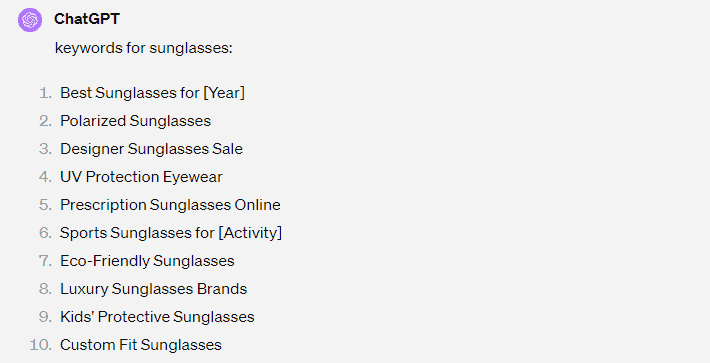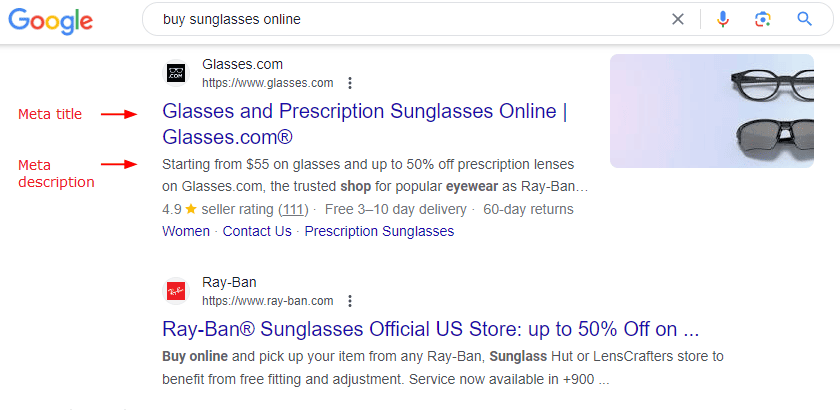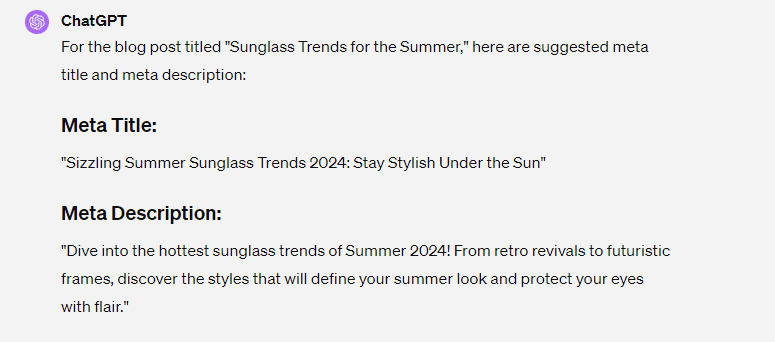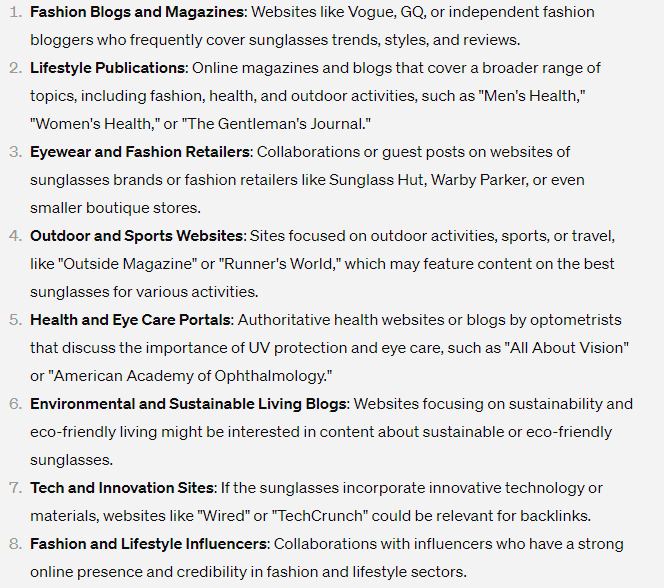Large language models (LLMs) and chatbots such as ChatGPT may not be specifically designed for SEO, but they still offer relevant applications, meaning that many website operators are already experimenting with the new tools. And why not? Google’s new spam policy has nothing against AI-generated content, after all. In fact, the search engine giant is currently developing its own chatbot, LaMDA, with the intention of integrating it into the search interface.
But how helpful is the current state of the art when it comes to search engine optimization? We tested it out on four classic SEO tasks:
1. Keyword brainstorming
Let’s say you’re setting up an online store for sunglasses and want to align the page structure with the most promising search terms. For that, you need the right keywords. If you enter the word “sunglasses” into the search window in ChatGPT, the AI will build what’s known as a keyword cluster with related search terms such as “sunglasses with colorful lenses” or “retro sunglasses”.
But watch out: while AI models may “understand” how SEO works, they don’t have access to real-time data. So you don’t know how promising the proposed keywords really are. However, they make a useful starting point for a more in-depth analysis, for example with Google’s keyword planner.

2. Content inspiration
Your sunglasses store is finally online! Now the only thing missing is visitors attracted by optimized content. For that, you need blog posts. But what about? Let’s ask ChatGPT.

This definitely gives us some ideas to work with. It’s useful to have an overview of potential topics, but unfortunately, ChatGPT doesn’t get particularly original or specific here. If we want to distinguish ourselves from hundreds of other existing blog posts, we’ll have to use our own brainpower rather than relying purely on technology.
3. Metatitle and metadescription help
Meta-what? First, let’s clarify the two terms.
The metatitle is the name you give to a webpage. It appears as a title both in the browser tab and in the search results. Each URL on your website should have a unique metatitle and, according to current SEO recommendations, should be a maximum of 60 characters long.
The metadescription, meanwhile, is a short summary of a webpage. It may not be visible on the page itself, but it is very important for helping search engines categorize it thematically. It is often displayed under the title in the search engine result. The current recommendation here is a maximum of 160 characters.

So, is ChatGPT up to this task? Well, yes and no.
The tool “knows” the terms “metatitle” and “metadescription”, and how they are used. However, it requires extremely clear instructions in order to reliably generate these metatexts, as the example below demonstrates: at 298 characters, the metadescription has really overshot the mark. Not to mention the style, which is painfully generic.

In short, while ChatGPT’s suggestions can provide useful inspiration, they should be treated as just that: inspiration for your own work, not ready-to-publish content. In addition, always keep in mind the principle “the more accurate the prompt, the better the result”.
4. Link-building
Links are what drive the internet – and they remain vital for SEO. There are two main types of links: backlinks (links on other sites that point to your site) and outgoing links (links on your site pointing to others).
If you want to drive traffic to your site, you’ll need to focus on backlinks. Basically, the motto here is “more is more”. But quantity isn’t the only thing that counts: the authority of the linking page is also decisive. The more popular and trustworthy the page from which you receive a backlink, the better. So let’s ask ChatGPT which sites could provide useful backlinks.

The tool also provides a helpful tip on the backlinking process.
ChatGPT can also offer recommendations for outgoing links, which you should use more sparingly. Only link readers to maximally trustworthy destinations that provide real added value.

Overall, ChatGPT performs pretty well at link-building. Now all that remains is the Sisyphean task of actually getting the relevant site operators to backlink to your shop. Fortunately, you’re already logged into ChatGPT and can just have it generate an email template for you.
Conclusion: inspiration, not automation
While not specifically programmed for search engine optimization, ChatGPT can provide valuable support in some areas. Generative AI is a useful tool for keyword clustering, brainstorming and link building. However, if you want more specific results, a specialized SEO tool might be a better bet. And either way, human brainpower remains the vital ingredient.
What you get out of a tool depends on what you put in. To generate usable SEO texts, ChatGPT needs crystal-clear instructions, as demonstrated by the example with the overly long metadescription.
In other words, what’s true of Google is also true of generative AI: to get the right answers, you first need to ask the right questions.
Looking for SEO texts that make an impact? Let’s talk.
Cover image by Andrea Piacquadio via Pexels
